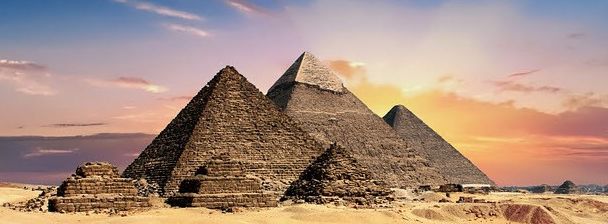
Egyptian Pyramids
For millennia, grave robbers and archaeologists have been digging tunnels in search of a hidden room in Khufu’s Pyramid (a.k.a. The Great Pyramid of Giza). Until today, they were literally searching in the dark. Now, using cosmic-ray muon radiography, Kunihiro Morishima’s, et al., publication in Nature is providing a roadmap, potentially a treasure map, to a previously unknown chamber in Khufu’s Pyramid. In their article, they report “Discovery of a big void in Khufu’s Pyramid by observation of cosmic-ray muons discovery of a large void (with a cross section similar to the Grand Gallery and a length of 30 m minimum) above the Grand Gallery, which constitutes the first major inner structure found in the Great Pyramid since the 19th century.”
Cosmic ray-muons are subatomic particles, with an electrical charge equal to an electron, but with a mass around 200 times greater than an electron. Muons form in the upper layer of the Earth’s atmosphere, the by-products of cosmic rays (i.e., a highly energetic atomic nuclei) colliding with molecules in the upper atmosphere. Traveling near the speed of light, approximately10,000 muons reach every square meter of the earth's surface a minute. Two factors make muons useful:
1. Their ability to penetrate solids deeper than x-rays
2. The difference in their speed in solids (i.e., slower) than air (i.e., faster)
Armed with this knowledge, Kunihiro Morishima, et al., used three different muon detection technologies and three independent analyses to confirm this hidden chamber, now named, “ScanPyramids Big Void.”
This marks the potential beginning of a new field in archeology, namely archeological cosmic-ray muon radiography. According to the Nature article, “While there is currently no information about the role of this void, these findings show how modern particle physics can shed new light on the world’s archaeological heritage.”
Using muons to generate three-dimensional images of volumes is not new. Developed in the 1950s, the technology is termed “muon tomography.” Current applications include detecting nuclear material in road transport vehicles and cargo containers for security reasons and non-invasive nuclear waste characterization for safety reasons. However, the Nature article marks the first archeological application.
Khufu’s Pyramid, built on the Giza Plateau (Egypt), dates back to the pharaoh Khufu, who reigned from 2509 to 2483 BCE. It is one of the oldest and largest monuments on Earth. However, there is no consensus regarding how the ancient Egyptians constructed it.
Muons have a rich history in scientific discovery. The Rossi–Hall experiment in 1940 confirmed Einstein’s time dilation effect, as predicted in his theory of special relativity. In 1963, the Frisch-Smith experiment confirmed the Rossi-Hall’s experiment and measured the mean muon velocities to be between 0.995 c and 0.9954 c (where c is the speed of light in a vacuum). In 1977, Bailey et al. measured the lifetime of positive and negative muons using the CERN Muon storage ring (particle accelerator). This experiment confirmed both time dilation and the twin paradox. The twin paradox predicts, via Einstein’s special theory of relativity, that one twin in a rocket ship traveling near the speed of light will age slower than the other twin, who is standing stationary on the Earth.
Our friend the muon continues to help us push back the frontiers of science, from Einstein’s special theory of reality to a hidden chamber in Khufu’s Pyramid.
